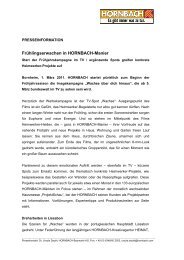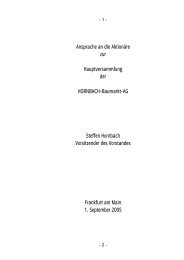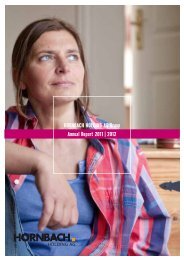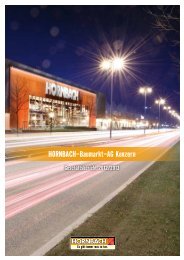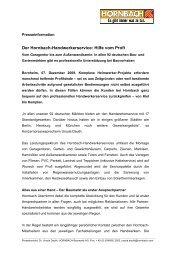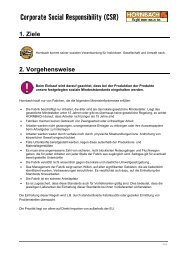Hornbach-Baumarkt-AG Group
PDF, 3,6 MB - Hornbach Holding AG
PDF, 3,6 MB - Hornbach Holding AG
- No tags were found...
Create successful ePaper yourself
Turn your PDF publications into a flip-book with our unique Google optimized e-Paper software.
66 GROUP MAN<strong>AG</strong>EMENT REPORT Risk Report<br />
Risk Report<br />
Risk management at the <strong>Group</strong><br />
All entrepreneurial activity directly involves opportunities and<br />
risks. Effectively managing opportunities and risks therefore<br />
represents a critical success factor in sustainably securing<br />
the company’s value. The Board of Management of HORN-<br />
BACH-<strong>Baumarkt</strong>-<strong>AG</strong> is committed to risk-conscious corporate<br />
management which accords top priority at all times to safeguarding<br />
the continued existence of the overall company and<br />
its subsidiaries. The risk management system (RMS) implemented<br />
by the Board of Management is intended to achieve<br />
ongoing enhancements in the early identification of risks with<br />
the aim of proactively managing such risks, as well as continuously<br />
optimizing the company’s opportunity/risk profile. On<br />
this basis, the Board of Management has adopted the following<br />
principles:<br />
Risk policy principles<br />
The generation of economic profit necessarily involves risk<br />
taking. Nonetheless, no action or decision may entail any<br />
existential risk, i.e. any threat to the continued existence of<br />
the company or any of its operations. As a matter of principle,<br />
the <strong>Group</strong> does not enter into any risks which relate neither to<br />
its core processes nor to its support processes. Core processes<br />
involve developing and implementing the respective business<br />
models, procuring merchandise and services, location decisions,<br />
safeguarding liquidity and developing specialist and<br />
management personnel. Any earnings risks entered into have<br />
to be justified by an appropriate level of expected return. The<br />
relevant key figures are based on the return on capital committed.<br />
Risks which cannot be avoided have to be insured<br />
against, where this is economically expedient. Residual risks<br />
have to be controlled by means of a range of risk management<br />
instruments.<br />
Organization and process<br />
The risk management system in place at the HORNBACH-<br />
<strong>Baumarkt</strong>-<strong>AG</strong> <strong>Group</strong> forms an integral part of the company‘s<br />
management structure. It consists of the central components<br />
of early risk identification, controlling and planning processes,<br />
reporting and an internal control system, and is continually<br />
enhanced and optimized.<br />
Responsibility for establishing, organizing and maintaining a<br />
suitable, target-based risk management system, and the<br />
internal control system in particular, lies with the Board of<br />
Management. In terms of the organization and maintenance<br />
of the system, the Board of Management is supported by the<br />
Director of <strong>Group</strong> Controlling / Risk Management.<br />
Risk managers at the <strong>Group</strong>’s operations in Germany and<br />
abroad are responsible for taking suitable measures to manage<br />
risks in their area of responsibility. When identifying and<br />
evaluating risks and determining appropriate measures to<br />
manage such risks, risk managers are supported by a central<br />
risk controller responsible for coordinating risk management<br />
processes and aggregating the risks thereby reported.<br />
Risks are evaluated in terms of their implications and their<br />
probability of occurrence and are allocated to so-called risk<br />
classes in which the risks are classified as representing<br />
“high”, “medium” or “low” risks overall. In cases where they<br />
cannot be quantified, they are assessed in terms of their<br />
qualitative implications. The target figures used at the <strong>Group</strong><br />
(including EBIT) serve as a basis for reference in this respect.<br />
The principles and regulations underlying the risk management<br />
system are documented in a risk management handbook.<br />
This sets out uniform principles for the overall <strong>Group</strong> concerning<br />
the structures and processes necessary for the early<br />
detection of risks. To support the risk management process, a<br />
standard software solution has been implemented across the<br />
<strong>Group</strong> which offers assistance in recording and documenting<br />
risks and the relevant risk management measures.<br />
Risks are updated quarterly and reported to the Board of<br />
Management. The Supervisory Board and Audit Committee<br />
discuss the current risk situation on a half-yearly basis.<br />
Alongside this scheduled reporting, ad-hoc reporting structures<br />
are also in place and have been implemented in the risk<br />
management process for risks arising unexpectedly.<br />
The internal control system currently in place is based on<br />
standardized documentation requirements at the <strong>Group</strong> for all



